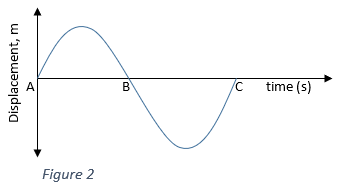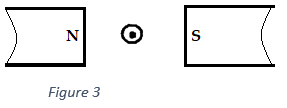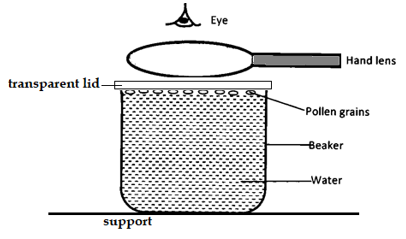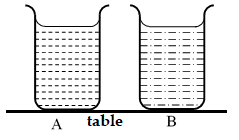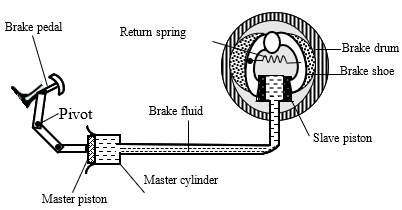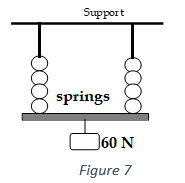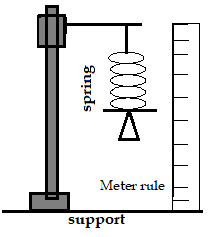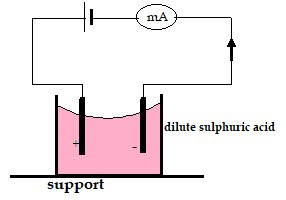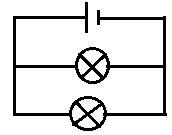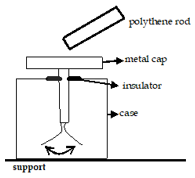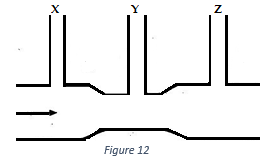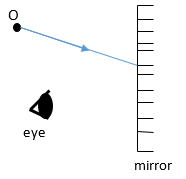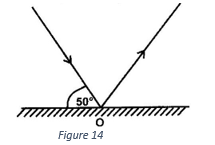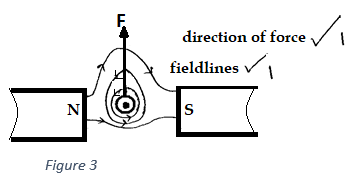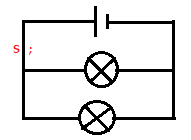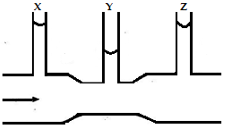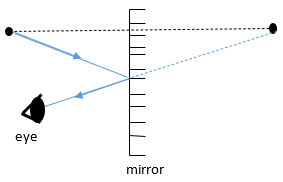Instruction to candidates
- This paper consists of two sections A and B
- Answer all questions in section A and B in the spaces provided
- All workings must be clearly shown, and Use the CONSTANTS given.
Gravitational acceleration, ‘g’ = 10m/s2
SECTION A (25 marks)
- Define the term ‘accuracy ‘and state the accuracy of a metre-rule (2 marks)
- A form one student was attempting an experiment when he got electrocuted. State the first aid measure that should be carried out to help him. (1 mark)
- Convert 4.304g/cm3 to kg/m3. (2marks)
- Figure 1, shows a book being pulled along the surface of a table.
Besides the tension force, label all the other forces acting on the book. (3 marks) - Why are gases easily compressible while liquids and solids are almost incompressible? (1 mark)
- Water flows steadily along a horizontal pipe at a volume rate of 8.0×10-3m3/s. If the cross-section area of the pipe is 20cm2.Calculate the velocity of the fluid. (3 marks)
- Convex mirrors are preferred to plane mirrors as vehicle side mirrors. Explain (1 mark)
- The diagram below (figure 2) shows a wave representing a water ripple (not drawn to scale)
If the speed of the ripple is 30cm/s and the distance AB = 6cm, determine- The frequency of the wave (2marks)
- The periodic time of the wave (2 marks)
- The figure below (figure 3) shows a conductor carrying current placed in the magnetic field of two magnets. Complete the diagram by showing the field pattern and the direction of force F that acts on the conductor. (2marks)
- A boy standing Infront of a cliff blows whistle and hears the echo after 0.5s. He then moves 17 metres away from the cliff and blows the whistle again. He now hears the echo after 0.6s. Determine the speed of the sound. (3marks)
- A student observed some pollen grains on the surface of water in a beaker with the help of hand lens as shown figure 4, below.
Figure 4- State the observation made. (1mark)
- Explain the observation in (a) above. (1mark)
- What conclusion can be drawn from the above experiment? (1mark)
SECTION B (55 MARKS)
- The figure 5 below shows two containers filled with two different liquids to the same height.
Figure 5- It was found that the pressure at the bottom of A is greater than that at B. Explain (1 mark)
- The figure below (figure 6) shows a car braking system. The brake fluid is an oily liquid.
The brake drum rotates with the wheel of the car.- Explain how pushing the brake pedal makes the brake rub against the drum. (4 marks)
- The cross-sectional area of the master piston is 2.0cm2. A force of 140N is applied to the master piston. Calculate the pressure created in the brake fluid by the master piston. (2 marks)
- The cross-sectional area of each slave piston is 2.8cm2. Calculate the force exerted on each slave piston by the brake fluid. (2 marks)
- The force exerted on the master piston is greater than the force applied by the foot on the brake pedal. Using the principle of moments, explain this. (2 marks)
-
- State ‘Hooke’s law’ (1 mark)
- It is easier to bend an iron rod than a glass rod of the same dimensions at the same temperature. Explain this. (1 mark)
- State two factors that govern the strengths of a spring of a given material. (2 marks)
- Two identical springs of spring constant 5.O N/cm are used to support 60N as shown in figure 7, below.
Determine the extension of each spring. (3 marks) - A student wants to find the mass of a Bunsen burner but has not got a balance. He has a steel spring, a pan, a lamp-stand, a ruler and a 100g mass. He arranges them as shown in the diagram (figure 8) below and uses them to obtain the result shown in the table alongside.
Figure 8
Load in pan Length of spring (mm) None 50 100g 150 Bunsen burner 200 - Suggest the relationship between the load and extension for any steel spring? (1 mark)
- Use the information in the table to find the mass of a Bunsen burner. (3 marks)
- The diagram below (figure 9) shows a series circuit.
Figure 9- A current of 2mA flows around the circuit.
- State the sub-atomic particle responsible for the flow of current (1mark)
- How much charge passes through the liquid in 3 minutes? (2marks)
- The capacity of an accumulator 120 Ah. What does this mean? (1 mark)
- Polarization is a defect in a simple cell. Explain the meaning of polarization and suggest how you would minimize its effect in the cell. (2 marks)
- The circuit below (figure, 10) shows lamps in parallel.
Indicate on the diagram with an S where you would put a switch to control both lamps together. (1 mark) - Polythene rod is rubbed with a cloth and held near to the cap of a metal leaf electroscope. The metal leaves move apart as shown in diagram below:
Figure 11- Explain what happens to the polythene rod when it is rubbed with the cloth (2 marks)
- The metal leaves move apart when the polythene rod is brought near to but not touching the metal cap. Explain.
(2 marks)
- Give two factors that affect the amount of charge on the leaves. (2 marks)
- A current of 2mA flows around the circuit.
- The figure 12, represents a tube through which liquid is flowing in the direction shown by the arrow. The vertical tubes have equal cross-sectional area.
- Show on the figure12, above, the relative positions of the level of the liquid in sections marked, X, Y and Z. (1 mark)
- Explain the meaning of:
- Streamline flow (1 mark)
- Turbulent flow (1 mark)
- State Bernoulli’s principle. (1 mark)
- Water flows in a horizontal smooth pipe. State the changes that would be observed in the nature of the flow if the speed of the water is steadily increased from low to high value? (1 mark)
- Two table Tennis balls are in the same level while suspended from threads a short distance apart. A stream of air is blown between the balls in a horizontal direction. Explain what happens to the balls. (2 marks)
- Water flows along a horizontal pipe of cross sectional area 30cm2. The speed of the water is 4m/s but it reaches 7.5m/s in a constriction in the pipe. Calculate the area of the constriction. (3 marks)
- It is dangerous to stand too close to a railway-line on which a fast moving train is passing. Explain. (2 marks)
- The figure 13, below shows a point object O placed in front of a plane mirror
Figure 13- On the same diagram, draw a ray to locate the position of the image, I, as seen from the eye E. (2 marks)
- Explain what is meant by a virtual image? (1 mark)
- State one disadvantage of a convex mirror as a driving mirror (1 mark)
- The diagram shows a ray of light incident on a plane mirror at point O.
The mirror is rotated clockwise through an angle of 300 about an axis perpendicular to the paper. Determine the angle through which the reflected ray rotated. (2 marks) - Give two main reasons why concave mirrors are unsuitable as driving mirrors (2 marks)
MARKING SCHEME
SECTION A (25 marks)
- Define the term ‘accuracy’ and state the accuracy of a metre-rule (2 marks)
- Accuracy refers to the least unit measurable from a measuring instrument;
Accuracy of a metre-rule = 0.1 cm;
- Accuracy refers to the least unit measurable from a measuring instrument;
- A form one student was attempting an experiment when he got electrocuted. State the first aid measure that should be carried out to help him. (1 mark)
- Put off the main switch of the electricity;
- Convert 4.304g/cm3 to kg/m3 . (2marks)
1g/cm3 = 1000kg/m3;
Therefore, 4.304g/cm3 = 4.304×1000=4304kg/m3; - Figure 1, shows a book being pulled along the surface of a table.;
Besides the tension force, label all the other forces acting on the book. (3 marks)
Figure 1 - Why are gases easily compressible while liquids and solids are almost incompressible? (1 mark)
- Gases have larger intermolecular distance;
- Water flows steadily along a horizontal pipe at a volume rate of 8.0×10-3m3/s. If the cross-section area of the pipe is 20cm2. Calculate the velocity of the fluid. (3 marks)
Rate of flow = aV ;
V = 8.0×10-3
0.002
= 4m/s ; - Convex mirrors are preferred to plane mirrors as vehicle side mirrors. Explain (1 mark)
- Convex mirrors have a wider field of view;
- The diagram below (figure 2) shows a wave representing a water ripple (not drawn to scale)
If the speed of the ripple is 30cm/s and the distance AB = 6cm, determine- The frequency of the wave (2marks)
λ=2×6=12 cm;
f = v/λ = 30/12 = 2.5Hz; - The periodic time of the wave (2 marks)
T = 1/f = 1/2.5; = 0.4seconds;
- The frequency of the wave (2marks)
- The figure below (figure 4) shows a conductor carrying current placed in the magnetic field of two magnets. Complete the diagram by showing the field pattern and the direction of force F that acts on the conductor. (2marks)
- A boy standing infront of a cliff blows whistle and hears the echo after 0.5s. He then moves 17 metres away from the cliff and blows the whistle again. He now hears the echo after 0.6s. Determine the speed of the sound. (3marks)
Time taken by sound to cover 17m
= 0.6 − 0.5
=0.1 seconds;
speed= 2d = 2×17 ;= 340ms-1;
t 0.1 - A student observed some pollen grains on the surface of water in a beaker with the help of hand lens as shown figure below.
- State the observation made. (1mark)
- Pollen grains were seen to be moving in constant random motion;
- Explain the observation in (a) above. (1mark)
- The grains were being hit continuously by the invisible water molecules which were also in random motion;
- What conclusion can be drawn from the above experiment? (1mark)
- matter is made up of tiny particles that are in constant random motion√
- State the observation made. (1mark)
SECTION B (55 MARKS)
- The figure 5 below shows two containers filled with two different liquids to the same height.
- It was found that the pressure at the bottom of A is greater than that at B. Explain (1 mark)
- Liquid A is denser than liquid B. ✔1
- The figure below (figure 6) shows a car braking system. The brake fluid is an oily liquid.
The brake drum rotates with the wheel of the car.- Explain how pushing the brake pedal makes the brake rub against the drum. (4 marks)
- When the pedal is pushed, pressure is generated in the master cylinder; ✔1 This pressure is transmitted to the slave cylinder; ✔1 This causes the pistons of the slave cylinder to open the brake shoe ✔1 and hence the brake lining presses the drum. ✔1
- The cross-sectional area of the master piston is 2.0cm2. A force of 140N is applied to the master piston. Calculate the pressure created in the brake fluid by the master piston. (2 marks)
P = F = 140 ; = 700,000Nm-2;
A 0.0002
- Explain how pushing the brake pedal makes the brake rub against the drum. (4 marks)
- The cross-sectional area of each slave piston is 2.8cm2. Calculate the force exerted on each slave piston by the brake fluid. (2 marks)
F = P x A ✔1
= 700,000 x 2.8 x 10-4
= 1,960N ✔1 - The force exerted on the master piston is greater than the force applied by the foot on the brake pedal. Using the principle of moments, explain this. (2 marks)
- Distance from the foot to pivot ✔1 is larger than the distance from piston to pivot;
- Force x distance = Constant ✔1 hence the force on master piston must be greater.
- It was found that the pressure at the bottom of A is greater than that at B. Explain (1 mark)
-
- State ‘Hooke’s law’ (1 mark)
- For an elastic material, extension is directly proportional to the applied force provided elastic limit is not exceeded.;
- It is easier to bend an iron rod than a glass rod of the same dimensions at the same temperature. Explain this. (1 mark)
- Iron is ductile while glass is not; so iron is easily bent than glass.
- State two factors that govern the strengths of a spring of a given material. (2 marks)
- Length of the spring (number of turns)
- Cross-sectional area of the material of the spring
- Two identical springs of spring constant 5.O N/cm are used to support 60N as shown in figure 7, below.
Determine the extension of each spring. (3 marks)
K1 = 5.0N/cm = 500N/m
Combined spring constant, Kp = 2K1 = 2×500 = 1000N/m;
Total extension, e = F = 60 = 0.06m;
Kp 1000
Hence, extension of 1 spring = 0.06 = 0.03m or 3 cm ;
2 - A student wants to find the mass of a Bunsen burner but has not got a balance. He has a steel spring, a pan, a lamp-stand, a ruler and a 100g mass. He arranges them as shown in the diagram (figure 8) below and uses them to obtain the result shown in the table alongside.
- Suggest the relationship between the load and extension for any steel spring? (1 mark)
- Extension of the steel spring is directly proportional to the amount of load applied.
- Use the information in the table to find the mass of a Bunsen burner. (3 marks)
Extension, e for 1N is (150-50) = 100mm
Spring constant, K = F = 1 = 10Nm-1;
e 0.1
Extension produced by Bunsen-burner = (200−50) = 150mm = 0.15m
Therefore, Weight = ke = 10×0.15 = 1.5N;
Mass = W = 1.5 = 0.15kg = 150g;
g 10
- Suggest the relationship between the load and extension for any steel spring? (1 mark)
- State ‘Hooke’s law’ (1 mark)
- The diagram below (figure 9) shows a series circuit.
- A current of 2mA flows around the circuit.
- State the sub-atomic particle responsible for the flow of current (1mark)
- Electrons;
- How much charge passes through the liquid in 3 minutes? (2marks)
Q = It = 0.002 × 3 × 60; = 0.36C;
- State the sub-atomic particle responsible for the flow of current (1mark)
- The capacity of an accumulator 120 Ah. What does this mean? (1 mark)
- A current of 120 amperes can be drawn from the accumulator in one hour.;
- Polarization is a defect in a simple cell. Explain the meaning of polarization and suggest how you would minimize its effect in the cell. (2 marks)
- Polarization is the accumulation of gas bubbles around the anode; it is minimized by the addition of a depolarizer; (e.g. potassium dichromate)
- The circuit below (figure, 10) shows lamps in parallel.
Indicate on the diagram with an S where you would put a switch to control both lamps together. (1 mark) - Polythene rod is rubbed with a cloth and held near to the cap of a metal leaf electroscope. The metal leaves move apart as shown in diagram below:
- Explain what happens to the polythene rod when it is rubbed with the cloth (2 marks)
- The rod gains electrons from the cloth; the presence of more electrons on the rod makes it negatively charged;
- The metal leaves move apart when the polythene rod is brought near to but not touching the metal cap. Explain.
(2 marks)- Electrons on the cap are repelled downward to the leaves; when both leaves have electrons (negative charges) they repel;
- Explain what happens to the polythene rod when it is rubbed with the cloth (2 marks)
- Give two factors that affect the amount of charge on the leaves. (2 marks)
- Amount of charge on the leaves;
- Distance of the polythene rod from the cap;
- A current of 2mA flows around the circuit.
- The figure 12, represents a tube through which liquid is flowing in the direction shown by the arrow. The vertical tubes have equal cross-sectional area.
- Show on the figure12, above, the relative positions of the level of the liquid in sections marked, X, Y and Z. (1 mark)
- Explain the meaning of:
- Streamline flow (1 mark)
- A type of flow where all the fluid particles passing through any given point in the fluid have the same velocity.
- Turbulent flow (1 mark)
- A type of flow in which the speed and direction of the fluid particles passing through a given point vary with time.
- Streamline flow (1 mark)
- State Bernoulli’s principle. (1 mark)
- Provided a fluid has a streamline flow, non-viscous and incompressible; the sum of the pressure, potential energy per unit volume and kinetic energy per unit volume is a constant;
- Water flows in a horizontal smooth pipe. State the changes that would be observed in the nature of the flow if the speed of the water is steadily increased from low to high value? (1 mark)
- At low speeds the speed is streamlined while at high speeds, the flow is turbulent;
- Two table Tennis balls are in the same level while suspended from threads a short distance apart. A stream of air is blown between the balls in a horizontal direction. Explain what happens to the balls. (2 marks)
- Balls move towards each other; pressure in the space between them decreases to below that on the outside. The pressure difference causes a force which pushes the ball towards each other;
- Water flows along a horizontal pipe of cross sectional area 30cm2. The speed of the water is 4m/s but it reaches 7.5m/s in a constriction in the pipe. Calculate the area of the constriction. (3 marks)
a1v1 = a2v2; ≡ 0.00324 = a2(7.5);
a2 = 0.0128 =0.001707m2;
7.5 - It is dangerous to stand too close to a railway-line on which a fast moving train is passing. Explain. (2 marks)
- Fast moving air between train and the person reduces pressure there; the outer atmospheric pressure is now greater which produces a force which pushes the person toward the train;
- Show on the figure12, above, the relative positions of the level of the liquid in sections marked, X, Y and Z. (1 mark)
- The figure 13, below shows an object O placed in front of a plane mirror
- On the same diagram, draw rays to locate the position of the image, I, as seen from the eye E. (2 marks)
- Explain what is meant by a virtual image? (1 mark)
- Image that cannot be formed on screen/ image formed by virtual rays
- State one disadvantage of a convex mirror as a driving mirror (1 mark)
- Forms a diminished image giving an illusion that the vehicle behind is far.
- The diagram shows a ray of light incident on a plane mirror at point O.
The mirror is rotated clockwise through an angle of 300 about an axis perpendicular to the paper. Determine the angle through which the reflected ray rotated. (2 marks)
Angle of rotation of reflected ray = 2(angle of rotation of mirrors)
= 2 x 30°
=60° - Give two main reasons why concave mirrors are unsuitable as driving mirrors (2 marks)
- Small field of view
- Highly magnified images which give a wrong perception of object distance.
- On the same diagram, draw rays to locate the position of the image, I, as seen from the eye E. (2 marks)
Join our whatsapp group for latest updates
Tap Here to Download for 50/-
Get on WhatsApp for 50/-
Download Physics Questions and Answers - Form 2 End Term 3 Exams 2023.
Tap Here to Download for 50/-
Get on WhatsApp for 50/-
Why download?
- ✔ To read offline at any time.
- ✔ To Print at your convenience
- ✔ Share Easily with Friends / Students


